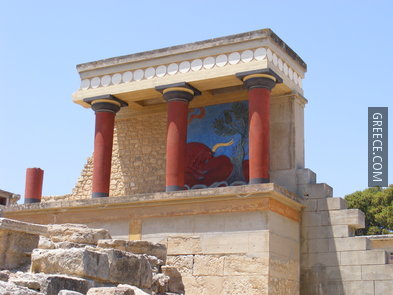General Information on Knossos
Knossos is the largest Bronze Age archaeological site of Crete, probably the ceremonial and political centre of the Minoan civilization and culture. It is larger, more complex, and more flamboyant than any of the other palaces known to us, and it is located about twenty minutes south of the port town of Heraklion. According to tradition, Knossos was the seat of legendary king Minos. The palace is also connected to thrilling legends, such as the myth of the Labyrinth and the Minotaur, and the story of Daidalus and Icarus.
The ruins at Knossos were discovered in 1878 by Minos Kalokairinos, a Cretan merchant and antiquarian. He conducted the first excavations, and resurfaced part of the storage magazines in the west wing and a section of the west façade. After Kalokairinos, several people attempted to continue the excavations, but it was not until March 16, 1900 that archaeologist Arthur Evans, an English gentleman of independent means, was able to purchase the entire site and conduct massive excavations.
Top Things to Do in Knossos
Numerous rooms, corridors, dogleg passages, nooks and crannies, and staircases prohibit a detailed walk-through description of the palace. However, the site, thanks to Evan’s reconstruction, is very easy to explore. The most significant parts of the complex are instantly recognisable.
The Palace of Knossos: The great palace was built gradually between 1700 and 1400 BC, with periodic rebuilding after destruction. It is the largest of the preserved Minoan palatial centres. The palace has an interesting layout, but the original plan can no longer be seen because of subsequent modifications. Also, there are not several main hallways. Instead, 1300 rooms are connected to corridors of varying size and direction. Four wings are arranged around a central courtyard, with royal quarters, workshops, shrines, storerooms, repositories, throne room, and banquet halls. The storerooms contained pithoi (large clay vases) with oil, grains, dried fish, beans, and olives. Many of the items were created at the palace itself, which had grain mills, oil presses, and wine presses. Under the pithoi were stone cylinders used to store more valuable objects, such as gold. The palace was created using advanced architectural techniques; for example, part of it was built five levels high.
To the west of the main palace lies the Little Palace. It has all the features of palatial architecture with scraped wall masonry, reception rooms, a prestyle hall, a double megaron with polythyra and a lustral basin- shrine.
To the northeast of the grand palace lies the Royal Villa. This construction is strongly religious in character and might have been the residence of an aristocrat or a high priest. Its architectural form is distinguished by the polythyra, the pillar crypt and the double staircase, with two flights of stairs.
To the northwest side of the grand palace is located the House of the Frescoes. It is a small urban mansion with rich decoration on the walls. To the south of the palace, visitors may see Caravanserai. This building was interpreted as a reception hall and hospice. Some of the rooms are equipped with baths and decorated with wall paintings.
Another building, the “Unexplored Mansion”, is situated northwest of the palace. This building was probably private or had some industrial function. It is rectangular, with a central, four-pillared hall, corridors, storerooms and remains of a staircase.
The so-called House of the High Priest lies 300m south of Caravanserai and contains a stone altar with two columns, framed by the bases of double axes. Connected to this building –via a paved street– was the Temple Tomb, located 600m south of the palace. It seems that one of the latter kings of Knossos (17th – 14th centuries BC) was buried here. Typical features of its architecture are the hypostyle, two-pillar crypt, the entrance with the courtyard, the portico and the small anteroom.
The centrepiece of the Mycenaean habitation of Knossos is the so-called Throne Room. This chamber has an alabaster seat identified by Evans as a “throne” built into the north wall. On three sides of the room are gypsum benches. An anteroom gave access to this one through two double doors. The anteroom in turn was connected to the central court, four broad steps up through four doors. Both rooms are located in the ceremonial complex west of the central court. The actual use of the room and the throne is unclear. According to one theory the building was the seat of a priest-king or his consort, the queen. This is the older theory by Evans. The second main theory is that a room was reserved for the epiphany of a goddess, who would have sat in the throne, either in effigy, impersonated by a priestess, or in imagination only.
Villa of Dionysos is another private, peristyle house that belongs to the Roman period. It is decorated with splendid mosaics by Apollinarius, depicting Dionysus. The house contains special rooms employed for the Dionysiac cult.
How to Reach Knossos
Regular buses operate from Heraklion. The No2 bus departs every 10min for Knossos from Bus Station A.
Weather in Knossos
The climate of Crete is the mildest of Greece and maybe of Europe. It is a temperate Mediterranean climate with hot and dry summers moderated by northern winds, and mild rainy winters in the plains. In the mountains of Crete, winters are quite harsh and it snows during the period from January to the end of February. Autumn is the mildest season in Crete, because temperatures are often higher than in spring and lower than in summer time.
Because the island is very mountainous, the changes of weather can be sudden and the mountains, as a barrier, create different weather conditions in northern and southern Crete.
Map of Knossos
 Athens Photos
Athens Photos
 Santorini Photos
Santorini Photos
 Crete Photos
Crete Photos
 Meteora Photos
Meteora Photos
 Corfu Photos
Corfu Photos

















